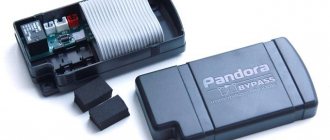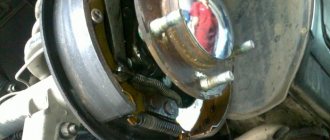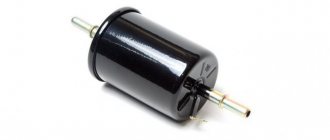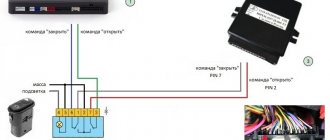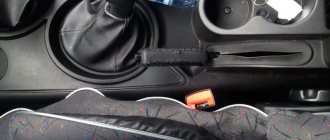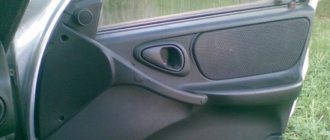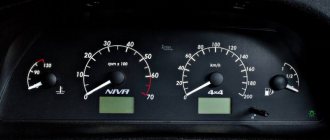03/02/2022 2,258 Electrical
Author: Victor
The reasons for the immo malfunction can be related to both the operation of the key fob and malfunctions in the unit’s software. If troubleshooting does not help, then you can disable the immobilizer on a Chevrolet Niva yourself in two ways: using a jumper or using a code.
[Hide]
Equipment
In Niva Chevrolet cars, the immobilizer is structurally composed of the following elements:
- main module, which allows you to turn the power unit locking on and off by sending a command to the control elements;
- machine engine blocking relay;
- diode indicator, which is located in the cabin; the installation location is chosen by the installer;
- a key that is inserted into the ignition switch, with its help you can start and stop the engine;
- a set of power cables for connecting the device to the on-board network;
- user manual, which describes all the nuances of installing and using the blocker.
The IZO))) LENTA channel spoke about malfunctions of blockers in VAZ cars.
Tips for care and maintenance of Niva Chevrolet
- Observe technical inspection intervals every 20,000 km;
- Buy original parts with factory catalog numbers. Avoid buying cheap analogues of dubious origin;
- During the warranty period from the manufacturer, visit a service station to undergo routine diagnostics with a note in the service book;
- Remember that the length of its service life depends on the driving style of the car;
- Observe the timing of the transition to the summer/winter tire seasons, check the tire pressure.
IMMO capabilities
What functions should the immobilizer perform:
- blocking machine movement systems through the use of one working data transmission channel;
- possibility of emergency shutdown of the blocker and transfer of the device to service mode;
- automatic activation and deactivation of the protective function; most immobilizers allow you to set a timer to activate the timed security mode;
- hood lock control.
APS-6 immobilizers can be synchronized to work with electric windows and fog lights. If necessary, they can be used to perform K-line diagnostics. If you install a more modern version of the blocker, wireless or contact, on your car, then such devices will have additional functions and capabilities:
- interactive authorization of the car owner, identification is carried out using a key made in the form of a plastic card;
- if IMMO performs automatic authorization, then identification is made using a special tag;
- modern devices allow you to connect up to five blocking relays simultaneously, and control can be carried out by both main and additional keys and tags;
- many device models have an anti-robbery function, and also switch the blocker into service mode using the Valet button, the latter can be used for control;
- To ensure reliable signal transmission, the latest technologies are used, this allows information to be transmitted at a higher speed;
- all modern immobilizers can function productively in the range of critical temperatures - from the lowest to the highest;
- bollards can function effectively not only inside the car, but also when installed outside.
The great Chiptuner spoke about removing the blocker from a Niva Chevrolet.
Where is it located and what does it look like
The block itself is made in a rectangular metal case. If the immobilizer is installed standardly, then at the factory it is installed under the plastic tunnel of the center console in the area of the car owner’s right leg.
Blocker APS-6
APS-4
Chevrolet Nivas produced before 2004 were equipped with APS-4 immobilizers. Modern cars began to use APS-6 devices. In later versions of the car, it began to be installed on the steering column, and not in the tunnel.
Correct installation
The installation procedure is as follows:
- Turn off the ignition in the car, open the hood and turn off the power to the on-board network. To do this, use a key to loosen the clamp on the battery terminal and disconnect it. All work is carried out with the on-board network turned off in order to prevent possible short circuits and voltage drops.
- Then you need to provide access to the installation site of the blocker. Installing it in the tunnel next to the driver’s right foot is not the most reliable option. It is better to place the lock on the steering column. To do this, dismantle part of the cladding, unscrew all the screws that secure the plastic linings, and remove them. Make sure that there are no moving elements at the installation site; their impact could damage the blocker. Provide access for laying wires to the device installation site.
- At the next stage, the main control unit is installed. Lock it in place. During movement, the module should not be exposed to vibration, otherwise the device will fail. Securely secure it with self-tapping screws. It is important that the immobilizer is disguised, this will prevent it from being disabled in the event of a break-in or illegal entry into the car. You can hide the device in the standard wiring harness.
- All the wires that come with the kit are laid at the installation site. Depending on the immobilizer model, the number of cables differs. They can be used not only to block the power unit, but also to control other systems and components. If the device is not contactless, then you need to connect the wires to all mechanisms, from the ignition switch to the auxiliary systems. To do this, use the diagram that is included in the package.
- At the next stage, the installation of blocking relays or sensors is carried out; here everything depends on the type of blocker.
- A diode indicator is installed in the car interior. There are two installation options - hidden and open. Sometimes mounting a light bulb openly can deter potential thieves. But some car owners choose a hidden installation option, then the criminal will not know about the presence of IMMO and engine blocking may confuse him. The attacker will need time to find the blocker and disable it.
- At the last stage, the procedure for programming and training the blocking device is carried out. The process is carried out in accordance with the indicators specified in the service manual.
None Auto electrician Sergei Zaitsev spoke about installing the bollard himself.
We change the Shnivy ignition switch. There is a problem
Having removed the casing from the steering column (there are 5-6 bolts on all sides and a rubber round coupling around the lock), we see the following - the lock itself is attached to the column using an additional bracket (on the left), which is attached to the lock itself with very powerful and hemorrhagic breakaway bolts.
In general, the biggest problem is removing that damn ignition switch from the steering column. It is secured with 4 breakaway bolts, which are specifically designed to make it more difficult to steal a car.
That is, they are easy to tighten; the caps have hexagonal key heads, which, at a certain tightening torque, break and a round cap remains. This is what we will need to unscrew, as many as 4 pieces. It turns out that putting it on is easy, but taking it off is difficult.
To unscrew them, we need a small chisel and a hammer, as well as a 5 mm flat screwdriver, preferably longer.
We unscrew it COUNTER-clockwise, adjust the chisel so that the angle of inclination is sharper, so that the force of the blow goes sideways, and not directly into the head. And we try to make a notch on the head of the breakaway bolt with a chisel; the most important thing here is to remove the bolt from the thread so that, once stuck, it begins to move.
Thus, moving the chisel, punching 3-4 mm at a time, we turn the bolt to the left until it loosens. Then you can unscrew it with your fingers or pliers if it still doesn’t turn well.
This is what such a bolt looks like, it goes to the cone. Let's take on the second one.
The most difficult one will be the one on the upper right; it will be very difficult to climb there.
Having unscrewed the bolts, you have practically won, now you can replace the lock itself without any problems, everything is quite simple, you disconnect 4 wires - red, blue, pink and black. True, you will also have to unscrew the lock itself from the second part of the fastening - using a Phillips screwdriver, 3 bolts.
By unscrewing these 3 bolts, you can disconnect the ignition switch from the fasteners or (in our case) you can remove the “cylinder” of the lock and thereby repair it.
Disabling the immobilizer
What are the options for deactivating the blocker:
- entering a personal password on the control panel inside the car;
- fixing the key to the antenna adapter of the device to disable the blocker;
- the use of various crawlers, emulators and other devices;
- use of jumpers;
- installation of software to deactivate the blocker.
You can learn about the nuances that a car owner may encounter when disabling the blocker from the video of the KV Avtoservis channel.
Wait a minute...
Please enable cookies and reload the page.
This process is automatic. Your browser will shortly redirect you to the requested content.
Wait up to 5 seconds...
+ ((! + [] + (!! []) + !! [] + !! [] + !! [] + !! [] + !! [] + !! [] + !! [] + []) + (! + [] + (!! []) — []) + (! + [] — (!! [])) + (! + [] + (!! []) +! ! [] + !! []) + (+ !! []) + (! + [] + (!! []) + !! [] + !! [] + !! [] + !! [] + !! [] + !! [] + !! []) + (! + [] + (!! []) + !! [] + !! [] + !! [] + !! [] + !! [] + !! []) + (! + [] + (!! []) — []) + (! + [] + (!! []) + !! [])) / + ( (! + [] + (!! []) + !! [] + !! [] + []) + (+ !! []) + (! + [] + (!! []) + !! [] + !! []) + (+ !! []) + (! + [] — (!! [])) + (! + [] + (!! []) + !! [] +! ! []) + (! + [] — (!! [])) + (! + [] — (!! [])) + (! + [] + (!! []) + !! [] + !! []))
+ ((! + [] + (!! []) + !! [] + !! [] + !! [] + !! [] + !! [] +! ! [] + []) + (! + [] + (!! []) + !! []) + (! + [] + (!! []) + !! [] + !! [] + !! [] + !! [] + !! [] + !! []) + (! + [] — (!! [])) + (! + [] + (!! []) + !! [] + !! []) + (+ !! []) + (! + [] + (!! []) + !! [] + !! [] + !! [] + !! []) + (! + [] + (!! []) + !! [] + !! []) + (! + [] + (!! []) + !! [] + !! [] + !! [] + !! [] + !! [])) / + ((! + [] + (!! []) + !! [] + !! [] + !! [] + !! [] + []) + (! + [] + (!! []) + !! [] + !! []) + (! + [] + (!! []) + !! [] + !! [] + !! []) + (! + [] + (!! []) + !! [] + !! [] + !! [] + !! []) + (! + [] + (!! []) + !! [] + !! [] + !! [] + !! []) + (! + [] + (!! []) + !! []) + (! + [] + (!! []) + !! []) + (! + [] + (!! []) + !! [] + !! [] + !! [] + !! [] + !! [] + !! [] + !! []) + (! + [] + (!! []) + !! [] + !! [] + !! [] + !! [] + !! [] + !! [] + !! []))
+ ((! + [] + (!! []) + !! [] + !! [] + !! [] + !! [] + !! [] + !! [] + []) + (+ !! []) + ( ! + [] + (!! []) + !! [] + !! [] + !! [] + !! [] + !! []) + (! + [] + (!! []) + !! [] + !! [] + !! []) + (! + [] — (!! [])) + (! + [] + (!! []) + !! [] +! ! []) + (! + [] + (!! []) — []) + (! + [] + (!! []) + !! [] + !! []) + (! + [ ] + (!! []) + !! [])) / + ((! + [] + (!! []) + !! [] + !! [] + []) + (! + [] + (!! []) + !! [] + !! [] + !! [] + !! [] + !! []) + (! + [] + (!! []) + !! [ ] + !! []) + (! + [] + (!! []) + !! [] + !! []) + (! + [] + (!! []) + !! [] + !! [] + !! [] + !! [] + !! [] + !! [] + !! []) + (! + [] + (!! []) + !! [] +! ! [] + !! [] + !! [] + !! [] + !! [] + !! []) + (! + [] + (!! []) + !! [] + !! [] + !! [] + !! [] + !! [] + !! [] + !! []) + (+ !! []) + (+ !! []))
+ (( ! + [] + (!! []) + !! [] + !! [] + !! [] + !! [] + !! [] + !! [] + []) + (+ !! []) + (! + [] + (!! []) + !! [] + !! [] + !! [] + !! [] + !! []) + (! + [] + ( !! []) + !! [] + !! [] + !! []) + (! + [] — (!! [])) + (! + [] + (!! []) +! ! [] + !! []) + (! + [] + (!! []) — []) + (! + [] + (!! []) + !! [] + !! [] + !! []) + (! + [] + (!! []) + !! [])) / + ((! + [] + (!! []) + !! [] + !! [] + []) + (! + [] + (!! []) — []) + (! + [] + (!! []) + !! [] + !! [] + !! []) + (! + [] + (!! []) + !! [] + !! []) + (! + [] + (!! []) — []) + (! + [] + (! ! []) + !! [] + !! [] + !! [] + !! [] + !! []) + (! + [] + (!! []) + !! []) + (! + [] — (!! [])) + (! + [] + (!! []) + !! [] + !! [] + !! [] + !! [] + !! [ ]))
+ ((! + [] + (!! []) + !! [] +! ! [] + !! [] + !! [] + !! [] + !! [] + !! [] + []) + (! + [] + (!! []) — []) + (! + [] — (!! [])) + (! + [] + (!! []) + !! [] + !! []) + (+ !! []) + (! + [ ] + (!! []) + !! [] + !! [] + !! [] + !! [] + !! [] + !! [] + !! []) + (! + [] + (!! []) + !! [] + !! [] + !! [] + !! [] + !! [] + !! []) + (! + [] + (!! [] ) — []) + (! + [] + (!! []) + !! [])) / + ((! + [] + (!! []) + !! [] + !! [] + !! [] + []) + (! + [] + (!! []) + !! [] + !! [] + !! [] + !! []) + (! + [] + (!! []) + !! []) + (! + [] — (!! [])) + (+ !! []) + (! + [] + (!! []) + !! [] + !! [] + !! [] + !! [] + !! [] + !! [] + !! []) + (! + [] + (!! []) + !! [ ]) + (! + [] + (!! []) + !! [] + !! [] + !! [] + !! [] + !! []) + (! + [] + (! ! []) + !! [] + !! [] + !! []))
+ ((! + [] + (!! []) + !! [] + !! [] + !! [] + !! [] + !! [] + !! [] + !! [] + []) + (! + [] + (!! []) — []) + (! + [] — (!! [])) + (! + [] + (!! []) + !! [] + !! []) + (+ !! []) + (! + [] + (!! [ ]) + !! [] + !! [] + !! [] + !! [] + !! [] + !! [] + !! []) + (! + [] + (!! [] ) + !! [] + !! [] + !! [] + !! [] + !! [] + !! []) + (! + [] + (!! []) — []) + (! + [] + (!! []) + !! [])) / + ((! + [] + (!! []) + !! [] + !! [] + !! [] + !! [] + !! [] + !! [] + []) + (! + [] + (!! []) + !! [] + !! [] + !! []) + (! + [] + (!! []) + !! []) + (! + [] + (!! []) + !! [] + !! [] + !! [] + !! [] + !! [] + !! [] + !! []) + (! + [] — (!! [])) + (! + [] + (!! []) + !! [] + !! [] + !! [] + !! [] + !! []) + (! + [] + (!! []) + !! [] + !! []) + (! + [] — ( !! [])) + (! + [] + (!! []) + !! [] + !! [] + !! [] + !! [ ] + !! [] + !! [] + !! []))
+ ((! + [] + (!! []) + !! [] + !! [] + !! [] + !! [] + !! [] + !! [] + []) + (! + [] + (!! []) + !! [] + !! [] + !! []) + (! + [] + (!! []) + !! [] + !! [] + !! [] + !! [] + !! [] + !! []) + (! + [] + (! ! []) + !! [] + !! [] + !! []) + (! + [] + (!! []) + !! [] + !! [] + !! [] +! ! [] + !! [] + !! [] + !! []) + (! + [] + (!! []) + !! [] + !! [] + !! [] + !! [] + !! [] + !! [] + !! []) + (! + [] + (!! []) + !! [] + !! [] + !! []) + (! + [] — (!! [])) + (! + [] + (!! []) + !! [])) / + ((! + [] + (!! []) + !! [ ] + !! [] + []) + (! + [] — (!! [])) + (! + [] + (!! []) + !! [] + !! [] + !! [] + !! [] + !! [] + !! []) + (+ !! []) + (! + [] + (!! []) + !! [] + !! [] + !! []) + (! + [] — (!! [])) + (! + [] + (!! []) + !! [] + !! [] + !! []) + ( + !! []) + (! + [] + (!! []) + !! [] + !! [] + !! []))
+ ((! + [] + (!! [ ]) + !! [] + !! [] + !! [] + !! [] + !! [] + !! [] + !! [] + []) + (! + [] + (! ! []) + !! [] + !! []) + (+ !! []) + (! + [] — (!! [])) + (! + [] + (!! []) + !! [] + !! [] + !! [] + !! [] + !! [] + !! []) + (! + [] + (!! []) + !! []) + (! + [] + (!! []) + !! [] + !! [] + !! [] + !! [] + !! [] + !! [] + !! []) + (! + [] + (!! []) + !! [] + !! [] + !! [] + !! [] + !! [] + !! []) + (+ !! [] )) / + ((! + [] + (!! []) + !! [] + !! [] + !! [] + []) + (! + [] — (!! [])) + (! + [] + (!! []) + !! [] + !! [] + !! [] + !! [] + !! [] + !! []) + (! + [] + (!! []) + !! [] + !! [] + !! []) + (! + [] — (!! [])) + (! + [] + (!! []) + !! [] + !! [] + !! [] + !! [] + !! [] + !! []) + (! + [] + (!! []) + !! [] + !! [] + !! []) + (! + [] + (!! []) + !! [] + !! [] + !! [] + !! [] + !! [] + !! []) + (! + [] + (!! []) + !! [] + !! [ ] + !! [] + !! [] + !! [] + !! [] + !! []))
+ ((! + [] + (!! []) + !! [] + !! [] + !! [] + !! [] + !! [] + !! [] + !! [] + []) + (! + [] + (!! []) + !! [ ] + !! []) + (+ !! []) + (! + [] — (!! [])) + (! + [] + (!! []) + !! [] + !! [] + !! [] + !! [] + !! [] + !! []) + (! + [] + (!! []) + !! []) + (! + [] + ( !! []) + !! [] + !! [] + !! [] + !! [] + !! [] + !! [] + !! []) + (! + [] + (! ! []) + !! [] + !! [] + !! [] + !! [] + !! [] + !! []) + (+ !! [])) / + ((! + [] + (!! []) + !! [] + !! [] + !! [] + !! [] + []) + (! + [] + (!! []) — []) » + (! + [] + (!! []) + !! [] + !! [] + !! []) + (! + [] + (!! []) + !! [] + !! [] + !! [] + !! [] + !! [] + !! [] + !! []) + (! + [] + (!! []) + !! [] + !! [ ] + !! [] + !! []) + (! + [] + (!! []) + !! [] + !! [] + !! [] + !! []) + (! + [] + (!! []) + !! [] + !! [] + !! [] + !! [] + !! []) + (+ !! []) + (! + [] + (!! []) + !! [] + !! [] + !! [] + !! [] + !! []))
+ ((! + [] + (!! []) + !! [] + !! [] + !! [] + !! [] + !! [] + !! [] + !! [] + []) + (! + [] + (!! [] ) + !! [] + !! []) + (+ !! []) + (! + [] — (!! [])) + (! + [] + (!! []) + !! [] + !! [] + !! [] + !! [] + !! [] + !! []) + (! + [] + (!! []) + !! []) + (! + [] + (!! []) + !! [] + !! [] + !! [] + !! [] + !! [] + !! [] + !! []) + (! + [] + (!! []) + !! [] + !! [] + !! [] + !! [] + !! [] + !! []) + (+ !! [])) »/ + ((! + [] + (!! []) + !! [] + []) + (! + [] + (!! []) + !! [] + !! [] + !! [] + !! []) + (! + [] + (!! []) + !! [] + !! [] + !! [] + !! [] + !! [] + !! []) + (! + [] + (!! []) + !! []) + (! + [] + (!! []) — []) + (! + [] + (!! []) + !! [] + !! [] + !! [] + !! []) + (! + [ ] + (!! []) + !! []) + (! + [] + (!! []) + !! [] + !! [] + !! [] + !! []) + ( ! + [] + (!! []) + !! [] + !! [] + !! [] + !! []))
+ ((! + [] + (!! []) + !! [] + !! [] + !! [] + !! [] + !! [] + []) + (! + [] + (!! []) + !! [] + !! [ ] + !! [] + !! [] + !! [] + !! [] + !! []) + (! + [] + (!! []) + !! [] + !! [] + !! [] + !! [] + !! []) + (! + [] — (!! [])) + (! + [] — (!! [])) + (! + [] + (!! []) + !! []) + (! + [] + (!! []) + !! [] + !! []) + (! + [] + (!! []) + !! []) + (! + [] + (!! []) + !! [] + !! [] + !! [] + !! [] + !! [])) / + (( ! + [] + (!! []) + !! [] + !! [] + !! [] + !! [] + !! [] + []) + (+ !! []) + ( ! + [] + (!! []) + !! [] + !! []) + (! + [] + (!! []) + !! [] + !! [] + !! [] + !! [] + !! []) + (! + [] + (!! []) + !! [] + !! [] + !! [] + !! [] + !! [] + !! [] + !! []) + (! + [] — (!! [])) + (+ !! []) + (! + [] + (!! []) + !! [] + !! [] + !! [] + !! [] + !! []) + (! + [] + (!! []) + !! [] + !! [] + !! [] + !! []))
.
Why disable the immobilizer?
In some cases you may need to disable the device:
- The car engine can be started without deactivating the lock. If the device does not perform its primary function, this means that the blocker is not functioning correctly. The device may block the operation of the unit.
- Problems have arisen in the operation of the device; the problems are related to one of the component parts of the complex.
- Severe or partial damage to the electrical wiring of the device has been detected. We are talking about circuits responsible for transmitting certain signals.
- If the blocker in use is obsolete and the car owner needs to disconnect the device in order to exchange it for a newer one.
- There was a need to install a standard car alarm.
Standard anti-theft system "Shnivy"
Control module location
Depending on the configuration, the Niva's electrical circuit can be supplemented with a standard alarm system, which, in essence, is a central locking system. If there is a lock, the system is controlled using one module - a block, which represents the signaling system.
The standard anti-theft system is characterized by the following monitoring features:
Since this system is standard, it does not have a notification function. That is, unlike a traditional signaling system, a standard anti-theft installation is not equipped with a siren. In other words, its main function is to lock the car doors, but if someone tries to break into the car or steal it, the driver will not know about it.
Photo gallery “Standard signaling”
1. Connection diagram for central locking
2. Control module microcircuit
Basic faults
What malfunctions may occur in the operation of the central locking:
Shutdown procedure
How to disable the blocker:
- Prepare jumper wire. When the blocker is disabled, the jumper will allow the exchange of information between the internal combustion engine control unit and the diagnostic output to be restored.
- To turn off the device, you can cut off the electrical circuits and then power them yourself. This option is more difficult to implement. If you need to use the diagnostic line, restoring it will be much more difficult than simply removing the jumper from the plug.
- To clear the immobilizer memory, you will need to disconnect the blocker from the power supply. After this, the jumper is installed in contacts numbered 9 and 18.
- The next step will be replacing the standard chip with a special one. It must contain software to clear the blocker's memory.
- The key is inserted into the lock and the ignition is activated for a few seconds. During this time, the blocker will automatically clear its memory and perform a flashing.
Fuel rail
On the ramp next to regulator 5 there is a control fitting 3. It is closed with a cap, which is unscrewed and then carefully pressed on the spool.
If fuel flows, it means it is entering the ramp. But perhaps the necessary pressure is not created. Reasons: clogged filter cylinder, pump malfunction, etc.
The pressure should be 350 kPa (3.5 bar). It is controlled by unscrewing the spool and installing a pressure gauge. Before checking, you need to reduce the pressure!
If fuel does not flow, notice whether the pump turns on when the key is turned to the “I” mark. When the ignition is turned on “cold”, the pump should run for 10 seconds.
Additional mounting block
Know that fuse F2 and relay P4 are responsible for turning on the pump. There is also a main relay P5, and all these elements are located in a block mounted on the same bracket with the ECM (see photo).
Even if the pressure is normal, the injectors may be clogged. In addition, their wiring may be damaged.
Case from practice
What happens if water gets into gasoline? In the summer - nothing. And in winter, the power supply system can become clogged with ice. All elements are at risk, from the pump to the injector valves!
What to do if you can’t disable the immobilizer and the car won’t start?
If the lock indicator is on on the dashboard, you cannot turn it off and the engine does not start, the reason is a malfunction of the IMMO. Then you can try to physically dismantle it from its installation location. Find where the blocker is located.
Remove it, unscrew the four screws securing the device, and disassemble the device. After dismantling, you will need to erase the memory of the non-volatile controller. To do this, you use a computer to which you need to connect a special PAK loader.
It is better to entrust the procedure for disabling IMMO on a Niva Chevrolet if it malfunctions to professionals.
Tags: immobilizer
Comments 10
check the power supply for immo. Looks like you cut it off.
The new training key will only be sewn into the new immobilizer unit. That's how it was intended at the factory. Therefore, it’s good that there was a fuse.
Remove the immobilizer. It’s done quickly and nah... not needed. Even if it works now, it may fail later at the most inopportune moment, especially since it is located very low - in the area of the driver’s right heel.
If the immo is stitched, then unfortunately it’s not easy to remove
All immobilizers have the same operating principle. They exchange a code with their brains, which is embedded in the immobilizer. When replacing brains or immobilizer malfunctions, a training key is required. Well, etc. and so on.
The bottom line is that when the immobilizer is disconnected from the circuit, a jumper is placed in the connecting block, and some kind of fornication is soldered into the brains, which blocks the sending of the code request. After which the brains simply stop asking the immobilizer for the correct code, but as if they immediately receive it and allow all car systems to start. The immobilizer itself works, only in limited mode, but the brain remains normal.
Something like this. I haven’t heard about the firmware of the immobilizer itself, unless there are some new versions. I have old cars)))
No. if the firmware in the brain of the immo is reset to default, then everything. on the drum on the immo. on its presence and absence. in general, it’s as if they never existed))
I haven't heard this. I removed it myself according to the scheme described above. Simple and fast.
The keys are registered not in the immobilizer, but in the brain. To reset the keys: 1. new brains. 2. reset the corresponding chip (removal, opening of the brain and programmer). 3. Resolder this chip to a new empty one.
Go to the nearest chiptuners and let them flash your brains with immo calving.
I got a Chinese fuse F20. Looks intact, but doesn't work.
The reasons for the immo malfunction can be related to both the operation of the key fob and malfunctions in the unit’s software. If troubleshooting does not help, then you can disable the immobilizer on a Chevrolet Niva yourself in two ways: using a jumper or using a code.
Where is the immobilizer located on a Chevrolet Niva
Finding and solving immobilizer problems
Disabling the immobilizer in a Chevrolet Niva
What to do if you can’t disable the immobilizer and the car won’t start?
Video “Disabling immo in a Niva Chevrolet”
Comments and Reviews
Electrical faults
- First of all, for all types and models of cars, you should pay attention to the battery - it can be worn out or simply discharged.
- The starter has become wet or has become unusable.
- The terminals may have oxidized, resulting in poor battery contact.
- Malfunctions are often due to defects in spark plugs, which occur when using low-quality fuel. Also, the spark plugs could simply wear out, forming a large gap.
- Another reason is a blown fuse.
- Broken ignition relay.
- It is possible that the wire supplying the starter or injector has been torn off.
- The immobilizer is not working.
